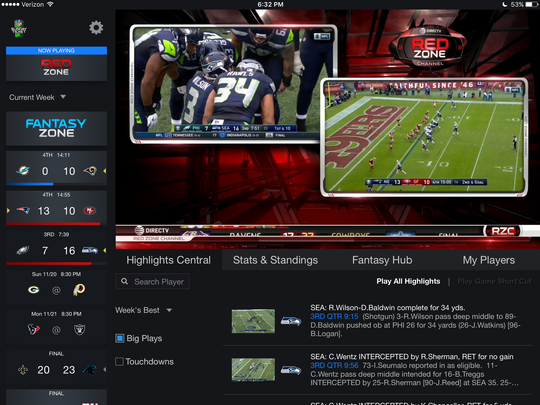
authentication service used by broadcasters. (To use many streaming apps provided by broadcasters, you’re required to enter your cable or satellite account. Adobe claims its TV Everywhere service has 99% of that market.) Adobe partnered with The Diffusion Group to study the trends in sports streaming, the results of which were provided to USA TODAY Sports. 
A screen shot of DirecTV NFL Sunday Ticket's NFLST.tv streaming service on a tablet showing the NFL RedZone Channel. (Photo: DirecTV)
The survey polled 2,000 U.S. consumers in July on their viewing habits to stream sports on any screen-- such as phones, computers and tablets-- as well as on their television via streaming devices like Amazon Fire TV, Apple TV and Roku and video game consoles.
The NFL had the most enthusiastic fan base as the the survey found that 48% of the respondents ranked themselves at a 9 or 10. (The 10-point scale started at 1 as “definitely not a fan” to a 10, “a super fan.”) The survey found the NFL is also the most streamed sport from Week 1 in September through February’s Super Bowl.
While broadcast ratings continue to lag, there appears to be no letup in streaming for NFL games. Each TV partner offers apps and, in some cases, their own streaming TV options that don’t require cable or satellite subscriptions.
This season also marks the debut of Thursday Night games on Amazon Prime Video, replacing Twitter which streamed Thursday night games last season.
Beyond Amazon the league also has streamed a game this season on Yahoo and offers fans with Verizon Wireless service or DirecTV Sunday Ticket subscriptions the ability to watch on their phones as well.
“Ratings are down, yes,” said Michael Greeson, director of research for The Diffusion Group. “Declines in legacy broadcast television has been too often tied to Nielsen’s ratings, which don’t take into account the viewing of connected devices used by people to watch live sports.Foster said that the current disparity between broadcast TV and streaming numbers will begin to converge in the coming years, although a true 1:1 ratio remains years off. But networks are already seeing the advantages of streaming sporting events --- especially with targeted ads that can’t be done on broadcast TV --- in an era where DVRs and services like Netflix and Hulu offer ad-free content.
“Live sports will continue to be a revenue stream for broadcasters and valuable to advertisers,” Foster said. “You can’t skip the ads because you’re watching the game in real time. Sports are a perishable asset. People tend not to record them and watch them later.”
The Diffusion Group estimated this year that the number of U.S. homes with broadband Internet service is expected to hit 100 million this year. Broadband-equipped homes surpassed the number of homes with pay TV service last year.
"Consumers don't care how they get the signal as long as the price is reasonable and the experience is equal (to cable or satellite)," Greeson said.
The survey showed a couple hurdles facing sports streaming, particularly when it comes to awareness.
Only 32% of respondents said they were aware that social media platforms like Facebook and Twitter --- both of which have made pushes into live sports in recent years --- have offered free live sports streaming. Also, only half of cable and satellite subscribers were aware that their subscriptions included access to streaming apps.
As for the national anthem protests that have dominated headlines in recent weeks and continues to draw criticism from President Donald Trump? The data remains inconclusive as to whether they have directly led to a drop in viewers. It is equally possible that fans are not tuning in as a result of poor matchups and sloppy play.
Other results of the study:
Registration reaps rewards.
Get exclusive access to our Behind the Story newsletter, new and beta features, the latest in tech, VR and podcasts, and invitations to USA TODAY NETWORK events and sweepstakes.
Sign Up
After the NFL, those most enthusiastic fan base – where respondents answered 9 or 10 on the scale -- were the Summer Olympics (38%), MLB (31%), Winter Olympics (30%), college football (30%) and the NBA (29%).
The TV remains the go-to appliance for live streaming sports (63%).
PCs (including laptops) make up the largest non-TV segment of sports streaming at 27%.
Respondents also said they used smartphones to stream sports (17% per the survey) and the NFL led as the most viewed sports on mobile phones with 70% responding they have watched the league’s games.
Tablets made were also utilized by 14% of the live sports streaming audience surveyed.